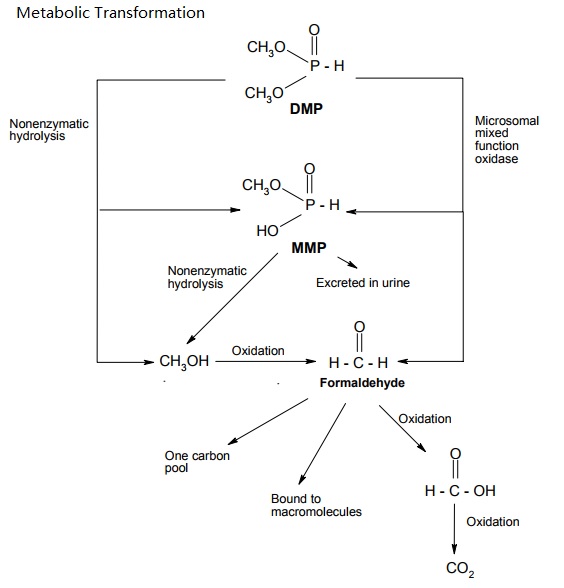DMP is a basic chemical which is used industrially as an intermediate. Because of its reactivity
DMP participates in a large number of chemical reactions:
- Addition to oxo compounds
- Addition to oxo compounds with subsequent condensation e.g. with amines
- Oxidation with oxygen or chlorine
- Addition to alkenes
Due to these properties DMP is used as an intermediate for the manufacturing of
- water treatment chemicals e.g. corrosion inhibitors for cooling-water circuits (about 50 %)
- pesticides and pharmaceuticals (about 20 %)
- flame retardants and other specialities (about 15 %)
- textile finishing products (about 15 %)
Dimethyl Phosphite (DMP) is rapidly absorbed via the oral and dermal routes. The main metabolic pathway in rodents is demethylation to monomethyl hydrogen phosphite (MMP) and further oxidation to CO2. DMP was mainly eliminated via urine and expired air. Over the studied dose range between 10 and 200 mg/kg bw and 5 x 200 mg/kg bw, respectively, only little evidence of bioaccumulation or saturation of absorption and elimination was observed. The only difference in studied toxicokinetics between rats and mice was the more rapid metabolism and elimination in mice.
An inhalation LC50 value is not available, but an exposure of 7100 mg/m³ (concentration estimated based on air flow and net loss of material) over 6 hours was not lethal for rats, mice and guinea pigs. Clinical signs were observed in mice only, and included occasionally laboured respiration after approximately 2 hours of exposure and ptosis after 5 hours. The acute dermal LD50 was 681 mg/kg bw (rabbits). Signs of intoxication were depression, ptosis, labored respiration, ataxia and placidity. The acute oral LD50 values were: 3283 mg/kg bw for male rats, 3040 mg/kg bw for female rats, 2815 mg/kg bw for male mice, and between 2150 and 3160 mg/kg bw for female mice. Clinical signs were inactivity, weakness, prostration and shallow breathing at doses near to or exceeding the LD50 values. White opaque eyes were seen in male mice.
Dimethyl Phosphite is irritating to the skin and eyes of rabbits. After prolonged or repeated exposures moderate to severe irritation of skin and mucosa was observed in rats. No sensitisation studies are available.

Proposed metabolic pathways of DMP in rats and mice (Nomeir and Matthews, 1997).
Suspected carcinogen
with experimental carcinogenic data.
Moderately toxic by ingestion and skin
contact. A skin and eye irritant. Mutation
data reported. When heated to
decomposition it emits toxic fumes of POx
Dimethyl hydrogen phosphite was not
mutagenic to several strains of Salmonella
typhimurium, but it did cause sister chromatid
exchanges and chromosomal aberrations in the
Chinese hamster CHO line.
An ACGIH threshold limit value (TLV)
has not been established for dimethyl hydrogen
phosphite.